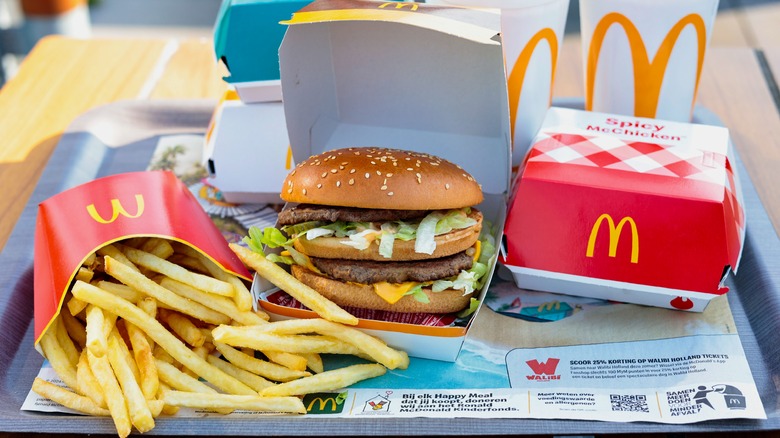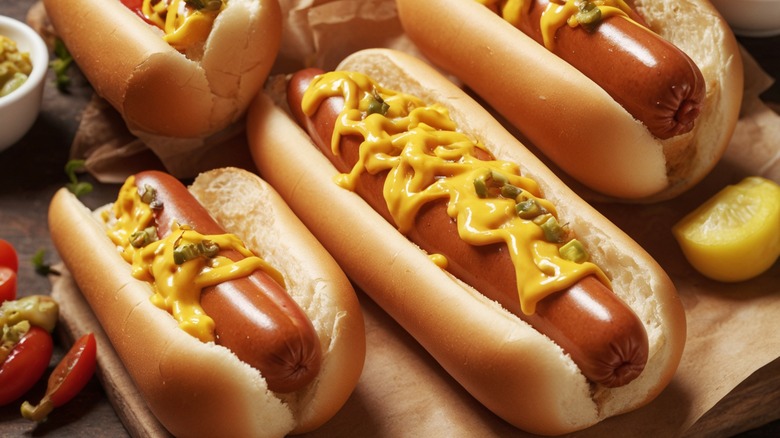The Reason McDonald's Hot Dogs Were Probably Never Going To Last
McDonald's does quite a brisk business in hamburgers — really brisk. McDonald's sells 75 hamburgers per second worldwide. Yet, over the years, this fast food giant has tried rolling out various other food items, from spaghetti to crab cakes, with sometimes disastrous results. Ray Kroc, the man who turned this hamburger chain into a massive global success, kept an open mind to new menu items, even testing out grilled pineapple and cheese on a bun, which he dubbed the Hula Burger. But when it came to hot dogs, he refused to consider them — even though the founders of McDonald's, Richard and Maurice McDonald, had sold them at the restaurant back in the 1940s and early 1950s before Kroc bought the business.
"There are some things we can do and maintain our identity, and there are others we can never do," Kroc wrote in his autobiography, "Grinding It Out: The Making of McDonald's." While he felt the company might one day serve pizza, hot dogs were a non-starter. "There's no telling what's inside a hot dog's skin, and our standard of quality just wouldn't permit that kind of item," Kroc wrote. While hot dogs are a beloved American food today, past rumors about the food's preparation — especially in the early 1900s — continued to dog it for years. Even so, after Kroc's death, McDonald's attempted to roll out a McDonald's version of the wiener, which didn't go well.
Muckraking and mystery meat
One possible reason for Ray Kroc's dismissal of the hot dog as not meeting the restaurant's standards is turn-of-the-century muckraking journalist and author Upton Sinclair. His 1906 novel "The Jungle" tore the lid off of the disgusting practices of the meat packing industry at that time and described how dead rats and sawdust often ended up in sausage. Even after the industry cleaned up its act, rumors and misinformation about what exactly hot dogs contained continued.
These days, what's in a hot dog is much more palatable, with the better brands using only beef, pork, turkey, or chicken meat. Typically, manufacturers make hot dogs using trimmings — pieces of meat left over from processing steaks, chops, and other cuts. Some lower quality brands may also include organs and other parts, often listed on the label as "variety meats" along with the specific organ used. Besides meat, hot dogs can contain a variety of other additives and preservatives, which may have also given Kroc pause about selling them at McDonald's.
The McHotDog?
Ray Kroc died in 1984, and in 1995, McDonald's decided to introduce the McHotDog. And perhaps the corporation should have stuck by Kroc's original decision to ban the wiener. When McDonald's launched the new menu item, it failed miserably. The company discontinued it in the United States, though it returned a few times within the next few years as a seasonal offering in selection locations. Since then, the McHotDog has made brief appearances as seasonal or limited time menu items in Chile and the U.K. and is still available in Japan.
It's possible the McHotDog may one day reappear, like the McDonald's mascot Hamburglar, who had been retired for years before making a recent comeback. Or it could end up just one of a long list of other failed culinary experiments that were once heralded by McDonald's as the next big thing, like McPizza, McSpaghetti, Fish McBites, or the infamous Hula Burger. If the equally miserable failure of rival Burger King's attempt at selling hot dogs is any indication — it rolled them out in 2016 and killed them less than a year later — it's pretty unlikely McDonald's will again sell wieners in the United States. And that would be a decision Kroc would have likely been happy with.


